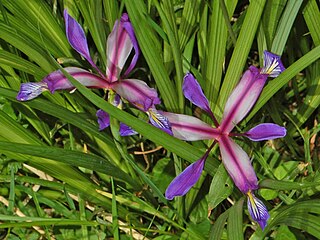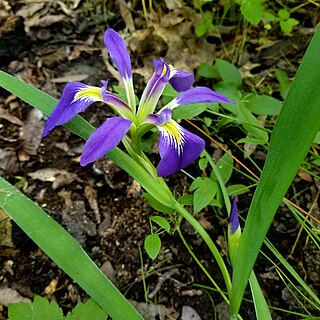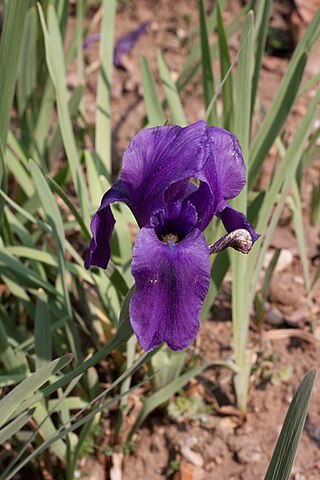
Iris giganticaerulea, the giant blue iris, is a species of iris, in the subgenus Limniris, in the series Hexagonae. It is a rhizomatous perennial, from northern America. It has long bright green leaves, very tall stems and one or two musky fragrant flowers in a range of blue shades or rarely white.

Iris cristata is a species in the genus Iris, it is also in the subgenus of Limniris. It is a rhizomatous perennial plant, endemic to the eastern United States. It has pale lavender flowers with a white patch and orange or yellow crest. It is a close relative to Iris lacustris, the only other crested iris native to North America. It is cultivated as an ornamental plant in temperate regions.

Iris graminea is a species of flowering plant belonging to the subgenus Limniris of the genus Iris, in particular the series Spuriae. It is a rhizomatous perennial, with purple or violet blue flowers almost hidden by narrow, grass-like leaves, and a plum scented fragrance. It is cultivated as an ornamental plant in temperate regions. It has several common names, including grass-leaved flag, grass leaved iris, plum iris and plum tart iris. This species naturally occurs in the southern half of Europe, from Spain and France in the West to Russia and the Caucasus in the East.

Louisiana iris is a taxonomic group of five iris species native to Louisiana and surrounding regions of the southeastern United States: Iris fulva, Iris hexagona, Iris brevicaulis, Iris giganticaerulea, and Iris nelsonii.

Iris variegata, commonly known as the Hungarian iris, is a plant species in the genus Iris, also in the subgenus Iris. It is a rhizomatous perennial from eastern Europe. It has dark green, ribbed leaves. The branched flowering stems can be as tall as the leaves, they can hold 2–3 flowers in summer. They are yellowish-white, with brown-purple veins on the drooping falls. It is very hardy and it is commonly cultivated as an ornamental plant in temperate regions. There are several cultivars.

Iris ruthenica, sometimes called ever blooming iris, Russian iris, pilgrim iris and Hungarian iris, is a species in the genus Iris- subgenus Limniris. It is a rhizomatous perennial, with a wide distribution, ranging from eastern Europe to Central Asia. It has grass-like leaves, thick stem and violet or bluish lavender flowers which are marked with violet veining.

Iris tridentata is a species in the genus Iris, it is also in the subgenus Limniris and in the series Tripetalae. It is a rhizomatous perennial, from the Southeastern United States. It has a cord-like rhizome, bright green leaves, long stem and fragrant flowers in spring in shades of blue.

Iris brevicaulis is a species in the genus Iris, it is also in the subgenus Limniris and in the series Hexagonae. It is a rhizomatous perennial, from North America. It has bright green, glossy long leaves, a long zig-zagged stem and 3–6 flowers per stem, which are come in blue shades from violet-blue, to lavender, to purple-blue, to bright blue to blue, and pale blue.

Iris fulva, also known as copper iris, is a species in the genus Iris, it is also in the subgenus Limniris and in the series Hexagonae. It is a rhizomatous perennial, endemic to the southern and central United States. It has copper-red to deep red flowers and bright green leaves.
Iris nelsonii is a species in the genus Iris, it is also in the subgenus Limniris and in the series hexagonae. It is a rhizomatous perennial, from northern America. It has long drooping, grass-like leaves, tall stems, 10 red-purple flowers.

Iris savannarum is a species in the genus Iris, it is also in the subgenus Limniris and in the series hexagonae. It is a rhizomatous perennial.
Iris odaesanensis is a beardless iris in the genus Iris, in the subgenus Limniris and in the series Chinenses of the genus. It is a rhizomatous herbaceous perennial from China and eastern Korea. It has blue-green grass-like leaves, short stem, 1 or 2 fragrant, white or off-white flowers in spring to early summer. It is a rare plant in the wild, but it is cultivated in east Asia.
Iris spuria subsp. musulmanica is a species of the genus Iris, part of a subgenus known as Limniris and in the series Spuriae. It is a subspecies of Iris spuria and is a rhizomatous perennial plant, from Armenia, Azerbaijan, Iran and Turkey in Asia with flowers in various shades of blue, but there are rare white forms. They have a yellow centre and darker veining. It has the common name of 'Muslim iris'. It is cultivated as an ornamental plant in temperate regions.
Iris falcifolia is a plant species in the genus Iris, it is also in the subgenus Iris and in the section Hexapogon. It is a rhizomatous perennial, from Uzbekistan, Kazakhstan, Afghanistan, Iran and Pakistan. It is a small plant, with sickle-shaped greyish-green leaves, lilac-violet flowers and darker veining, and a white or yellow beard. It is cultivated as an ornamental plant in dry, temperate regions.
Iris bloudowii is a species in the genus Iris, it is also in the subgenus of Iris and in the Psammiris section. It is a rhizomatous perennial, from Russia, Siberia, Kazakhstan, Mongolia and China, with sickle-shaped leaves, slender stem and 2 bright or pale yellow flowers. It is cultivated as an ornamental plant in temperate regions.

Iris darwasica is a plant species in the genus Iris, it is also in the subgenus Iris and in the section Regelia. It is a rhizomatous perennial, from Tajikistan and northern Afghanistan. It has long and thin glaucous to grey-green leaves, slender stem and greenish cream or greenish yellow, to dark purple or lilac flowers.

Iris hoogiana is a plant species in the genus Iris, it is also in the subgenus Iris and in the section Regelia. It is a rhizomatous perennial, from the grassy mountainsides of Turkestan. It has long green leaves, which are slightly purple at the base, and a long slender flowering stem. The flowers are blue, ranging from sky-blue to lavender blue and blue purple. It has orange or yellow beards. It is cultivated as an ornamental plant in temperate regions.

The identity of the plant first described by Carl Linnaeus as Iris florentina remains unclear, as of December 2021. In horticulture, it has been treated as a white-flowered variant of Iris × germanica, under names such as Iris germanica nothovar. florentina, Iris × germanica var. florentina and Iris × germanica 'Florentina'. Iris florentina has also been treated as the correct name for the true species also known as Iris albicansLange.

Iris scariosa is a plant species in the genus Iris, it is also in the subgenus Iris. It is a rhizomatous perennial, from the mountainsides of Russia, Kazakhstan, Mongolia and China. It has sword-like, or sickle shaped, blue green or grey-green leaves, a short flowering stem, 3 or 4 membranous or semi-transparent flower bud leaves, 2 violet, reddish violet, lilac, blue-purple, or blue flowers in late spring, with yellow or white beards. It is cultivated as an ornamental plant in temperate regions. It was merged with another similar iris in the region, and Iris glaucescens became a synonym of Iris scariosa, before being divided into two separate species again. Although some sources still call it the main species, despite a slight colour difference.
Iris griffithii is a plant species in the genus Iris, it is also in the subgenus Iris. It is a rhizomatous perennial, from Afghanistan. It has short, sickle-shaped leaves, short green stem and purple flowers with white beards. Several specimens exist within herbaria around Europe, but it is rarely cultivated.















